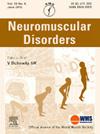02O Characterization of a mouse model for Jo-1, PL-7 and PL-12 associated anti-synthetase syndrome
IF 2.7
4区 医学
Q2 CLINICAL NEUROLOGY
引用次数: 0
Abstract
Anti-synthetase syndrome (ASyS) is an autoimmune condition, characterized by the presence of autoantibodies directed against an aminoacyl-tRNA synthetase (anti-ARS). Patients present clinical symptoms such as myositis, interstitial lung disease, Raynaud's phenomenon, and arthritis. Anti-Jo-1, anti-PL-7 and anti-PL-12 are the most frequent anti-ARS. However, their role in ASyS pathogenesis remains incompletely understood. Therefore, robust animal models are essential to gain a detailed insight into the underlying pathophysiology. Aiming to characterize these pathophysiological features, we established and studied a mouse model for Jo-1, PL-7 and PL-12 associated ASyS. ASyS was induced in NOD.Idd 3/5 mice by injection of 200 µg Jo-1, PL-7 or PL-12 recombinant protein emulsified in Complete Freund's Adjuvant (CFA) in combination with OX86. Controls received CFA and Phosphate Buffered Saline only. Muscle strength was assessed by rotarod tests and the effects on the peripheral immune system were investigated by flow cytometry in spleen and lymph nodes. Morphological characteristics of skeletal muscle and lung tissue of immunized mice and the tissue infiltrating immune cells were validated using histology and immunohistochemistry. Immunization of mice led to clinical symptoms including muscle weakness and demonstrated variations in the immune cell response between the ARS subtypes. Histological analysis of skeletal muscle tissues showed infiltration by immune cells in the epimysium, spreading into the adjacent perifascicular area with progressing disease. Analysis of lung specimens by immunohistological staining demonstrated peribronchial accentuated accumulation of lymphocyte aggregates. We present a mouse model, which recapitulates features of the human phenotype of ASyS, to study the molecular pathogenesis and provide new insights into the pathomechanisms.
02O Jo-1、PL-7 和 PL-12 相关抗合成酶综合征小鼠模型的特征描述
抗合成酶综合征(ASyS)是一种自身免疫性疾病,其特征是存在针对氨基酰-tRNA 合成酶(抗-ARS)的自身抗体。患者会出现肌炎、间质性肺病、雷诺现象和关节炎等临床症状。抗Jo-1、抗PL-7和抗PL-12是最常见的抗AS。然而,它们在 ASyS 发病机制中的作用仍不完全清楚。因此,要想详细了解潜在的病理生理学,必须建立强大的动物模型。为了描述这些病理生理学特征,我们建立并研究了与 Jo-1、PL-7 和 PL-12 相关的 ASyS 小鼠模型。向 NOD.Idd 3/5 小鼠注射 200 µg Jo-1、PL-7 或 PL-12 重组蛋白(乳化在完全弗氏佐剂(CFA)中)并结合 OX86,诱导 ASyS。对照组仅注射 CFA 和磷酸盐缓冲盐水。肌肉力量通过转体测试进行评估,对外周免疫系统的影响则通过脾脏和淋巴结的流式细胞术进行研究。免疫小鼠骨骼肌和肺组织的形态特征以及组织浸润的免疫细胞均通过组织学和免疫组化进行了验证。小鼠免疫后会出现包括肌无力在内的临床症状,并显示 ARS 亚型之间的免疫细胞反应存在差异。对骨骼肌组织的组织学分析表明,免疫细胞浸润了肌肉外膜,并随着病情发展扩散到邻近的筋膜周围区域。通过免疫组织染色法对肺部标本进行分析后发现,淋巴细胞聚集在支气管周围。我们提出了一个小鼠模型,该模型再现了人类 ASyS 表型的特征,用于研究分子发病机制,并为病理机制提供新的见解。
本文章由计算机程序翻译,如有差异,请以英文原文为准。
求助全文
约1分钟内获得全文
求助全文
来源期刊

Neuromuscular Disorders
医学-临床神经学
CiteScore
4.60
自引率
3.60%
发文量
543
审稿时长
53 days
期刊介绍:
This international, multidisciplinary journal covers all aspects of neuromuscular disorders in childhood and adult life (including the muscular dystrophies, spinal muscular atrophies, hereditary neuropathies, congenital myopathies, myasthenias, myotonic syndromes, metabolic myopathies and inflammatory myopathies).
The Editors welcome original articles from all areas of the field:
• Clinical aspects, such as new clinical entities, case studies of interest, treatment, management and rehabilitation (including biomechanics, orthotic design and surgery).
• Basic scientific studies of relevance to the clinical syndromes, including advances in the fields of molecular biology and genetics.
• Studies of animal models relevant to the human diseases.
The journal is aimed at a wide range of clinicians, pathologists, associated paramedical professionals and clinical and basic scientists with an interest in the study of neuromuscular disorders.
 求助内容:
求助内容: 应助结果提醒方式:
应助结果提醒方式:


